In this edition, we delve into Elon Musk's 5-step product development process that can transform your approach to building remarkable products. Whether you're a budding product manager or a tech enthusiast, these insights will reshape your perspective.
Step 1: Make Requirements Less Dumb
Product ideas are abundant, but their real value lies in refinement. Musk advises, "Challenge even brilliant ideas to make them smarter." Elon says, “The smarter the person, the more you have to work to improve the requirements. If the requirements come from a smart person, you have to be especially careful, because you might accept them without questioning them enough. Everyone is wrong sometimes.” His Model 3 journey illustrates how evolving requirements can yield groundbreaking results. Start by questioning and improving your product's foundation.
Step 2: Try to Skip the Part or Process Step
Elon advocates simplicity by eliminating unnecessary complexity. As Elon says, “If you are not occasionally adding things back in, you are not deleting enough. The bias tends to be, very strongly, let’s add this, in case we need it.” You can make an “in case,” argument for anything. Trim features and processes that don't align with your product's core purpose. This sharpens your focus on what truly matters, preventing overcomplication.
Step 3: Simplify / Optimize
Optimize judiciously; focus on elements that can't be skipped. Musk warns against optimizing things that shouldn't exist. Streamline product flows and simplify steps, but only for the essentials.
Step 4: Accelerate Cycle Time
Speed is essential, but it should be strategic. Elon advises, "Don't rush without refining the essentials first." The Model 3's journey highlights the significance of accelerating only the necessary steps to avoid costly mistakes. “You’re moving too slowly. Go faster. But don’t go faster until you have worked on the other three things first. If you’re digging your grave, you don’t want to do it faster. You want to stop digging your grave.”
Step 5: Automate
Automation is the final step. It follows refining requirements, skipping unnecessary parts, and accelerating essential steps. Musk's Model 3 experience underscores the importance of questioning requirements before automating processes. One example was the fiberglass pack between the floor and the battery pack. It was choking the entire production line. So, Elon made added a robot (step 5), made it faster (4), reduced the glue needed (3). It was still choking the line. But, then he asked, what is this pack for? The battery department said for noise. But, they were the battery department. So, then he asked the noise department. The noise department said for fire safety. They weren’t needed. The team should have questioned the requirement at the outset. Hence, you must follow the steps in order. Automation must be last.
Conclusion
Elon Musk's 5-step product development process is a testament to his innovative thinking. You don't need to be a fan to appreciate its wisdom. As you embark on your journey to build remarkable products, remember these steps. They can be your guiding principles, whether you're working with technology, exploring enterprise blockchains, or navigating fintech.
Watch this YouTube video (2 min)
Stay tuned for more insights, expert advice, and inspiring stories in our future editions.



